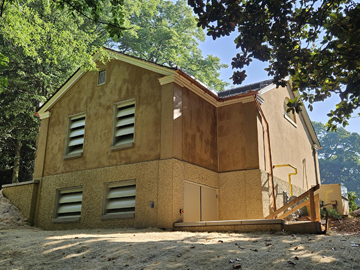Mark Hudson, Executive Director of Tudor Place Historic House & Garden, Washington, D.C.

Mark Hudson has been in the field of public history for more than 30 years, most of which has been spent leading historical societies and historic house museums:
- Curator, Boone County Historical Society, Missouri, 1994-1998
- Executive Director, Historical Society of Frederick County, Maryland, 1998-2009
- Executive Director, Vermont Historical Society, 2009-2015
- Executive Director, Tudor Place Historic House & Garden, 2015-present
His academic background includes the following:
- BA, history and communication studies, University of Kansas
- Master of Historical Administration & Museum Studies degree, University of Kansas
- BA, library science, University of Missouri
What led you to your field?
Since childhood I have held a fascination for American history and loved visiting museums and historic sites. After studying history as an undergraduate, I decided to pursue a career in public history, with an emphasis upon state and local history.
How does what you do relate to historic preservation?
Central to our mission at Tudor Place is the preservation and care of historical resources: architecture, landscapes, collections, and archives. We are constantly engaged in projects and activities to promote this. We also engage in activities that promote an understanding of historic preservation by the public and share information with other organizations.
Why do you think historic preservation matters?
Historic architecture, landscapes, collections, and archives provide tangible links with the past. They stand as solid evidence of values, beliefs, and activities of people in the past. By preserving these things, we help to ensure that this record of the past remains intact and can be experienced by future generations. This is especially important today as the historical record is being twisted to serve political agendas. Facts do matter, and tangible historical resources serve as solid evidence of the past.
What courses do you recommend for students interested in this field?
For students interested in historic preservation, I would recommend courses in the theoretical, practical, and legal aspects of historic preservation. I also would encourage them to engage with historic preservation organizations and projects by serving as a volunteer or doing an internship.
Do you have a favorite preservation project? What about it made it special?
Among preservation projects I have been directly engaged with, I would note two. First, the development of the Frederick County Heritage Preservation Center in 2003 was important. This project converted a vacant industrial building into a state-of-the-art center for the care of collections. The Historical Society of Frederick County received national recognition for this accomplishment.
The other project was the restoration of the bell tower at the Vermont History Center in 2010. The project arrested the deterioration of the brick masonry structure that was the signature architectural feature of an 1890 schoolhouse designed by Lambert Packard. This project was recognized by the State of Vermont as an exemplary historic preservation project.
Can you tell us what you are working on right now?

Much of my time and energy is being spent on the implementation of Tudor Place’s Master Preservation Plan. Current projects include the following:
- Construction of the Mower House to house an emergency generator
- Fundraising and design for the Garage Project to renovate and expand the facility to house a collections management center, archival research space, educational classroom, exhibition gallery, and landscape care facilities. The building will also house the mechanical plant that will serve this building and the Main House with geothermal environmental control systems
- Fundraising and design for upgrades to the electrical, mechanical, security, and life safety systems in the Main House
How do you think the national historic preservation programs help your community?
Located in the Georgetown Historic District, Tudor Place’s historic preservation activities fall under the purview of the Old Georgetown Board and the U.S. Commission on Fine Arts, both of which are federal agencies. Though controversial at times, these organizations help to ensure that the historical integrity of the community is preserved and provide guidance to property owners (including Tudor Place) on best practices. Other programs, like National Endowment for the Humanities grants, provide funding for historic preservation projects.
Do you have advice for novice preservationists?
Yes. Get involved with the organizations doing historic preservation in your community—especially the local historical society. Also, take advantage of learning opportunities in the classroom and beyond.
The ACHP’s mission is “preserving America’s heritage;” can you give us an example of how your community is preserving its heritage?
Yes. Tudor Place is part of a network of organizations that are preserving and sharing the stories of enslavement in Georgetown, an often-overlooked part of our history. Through these efforts, we are weaving together the lives of the enslaved and enslavers in our community, giving names and personality to the enslaved and accountability for the enslavers.
In your experience, what role does community engagement play in historic preservation, and how do you involve the local community in the preservation efforts at Tudor Place?
In addition to providing practical knowledge of historic preservation practices, organizations like Tudor Place bring the “hearts and minds” of the community to the cause through community engagement. Like the work we are doing with enslavement in Georgetown, these efforts promote an awareness that becomes advocacy.
How do you stay updated on the latest trends, techniques, and best practices in historic preservation? Are there any specific organizations, conferences, or resources you rely on to enhance your knowledge?
Several organizations provide relevant and timely information, including the American Association for State and Local History, the American Alliance of Museums, and the National Trust for Historic Preservation. Their conferences, workshops/seminars, and publications help keep us informed of current practices and projects. The National Park Service also has a lot of resources to promote best practices in historic preservation. The National Preservation Institute has training opportunities that can provide continuing education credits and certifications.
Read more Q&A stories about the Preservationists in Your Neighborhood!